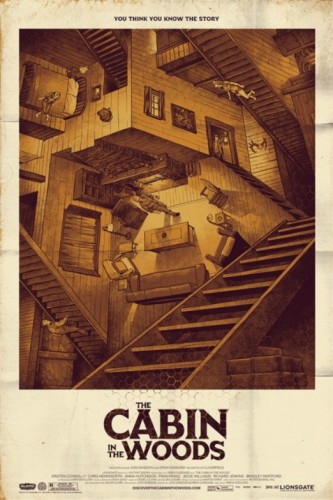 At first blush, Drew Goddard’s long-awaited meta-horror film Cabin in the Woods (my review) is designed to foster invested discussion of its genre among both its core and secondary audiences. It’s an unavoidable byproduct of meta-filmmaking of any kind; movies that peer behind the scenes, so to speak, lend themselves to more intensive conversation by virtue of their defining sense of self-awareness. Put differently, movie fans like talking about movies that are about movies, and Cabin, brandishing the tropes of horror cinema with an inwardly critical sense of pride, certainly fits that description. The film pulls off a tricky balancing act, existing as a genuine entry in horror canon while also serving as a multifaceted incisive exploration of the genre as a whole, speaking volumes to the nature of fandom and the state of contemporary horror.
At first blush, Drew Goddard’s long-awaited meta-horror film Cabin in the Woods (my review) is designed to foster invested discussion of its genre among both its core and secondary audiences. It’s an unavoidable byproduct of meta-filmmaking of any kind; movies that peer behind the scenes, so to speak, lend themselves to more intensive conversation by virtue of their defining sense of self-awareness. Put differently, movie fans like talking about movies that are about movies, and Cabin, brandishing the tropes of horror cinema with an inwardly critical sense of pride, certainly fits that description. The film pulls off a tricky balancing act, existing as a genuine entry in horror canon while also serving as a multifaceted incisive exploration of the genre as a whole, speaking volumes to the nature of fandom and the state of contemporary horror.
Since Goddard and Whedon have so much to say, it’s important to find a starting place. Maybe the best place to begin is at the end, as the massive, flaming hand of an Ancient One rises out of the pit beneath the eponymous cabin and smashes it into oblivion, killing survivors Marty and Dana in the process. The sacrificial ritual performed by Sitterson and Hadley, the two technicians we meet at the start of the film, has failed; the facility they manned has been overrun by the menagerie of monsters stabled within its depths, leading to the horrible slaughter of the entire staff. Outraged, the Ancient Ones lash out, and presumably destroy the entire human race. Unsatisfied even by the gallons of bloodshed during the final act, in which hapless scientists are brutally killed in myriad ways*, someone has to pay the price for their displeasure.
Taken at face value, the Ancient Ones just represent the final escalation of Goddard’s film, which itself ratchets the stakes upward until the director of the clandestine, cultish operation finally reveals the truth about the cabin and the activity taking place beneath it. Truthfully, Cabin in the Woods‘ climax is apocalyptic by default. Even before the Ancient Ones make their grand (if brief) entrance, Marty and Dana themselves kick-start the utter annihilation of the whole cinematic world Goddard has established; defiant to the end, and making use of a well-placed (depending on who you ask, of course) big red emergency button at the height of need, they refuse to lay down their lives and instead choose to hide in a control room while unbridled chaos rages around them. Following that extended sequence of kills, in fact, the arrival of the Ancient Ones feel tame by comparison. They deliver a far cleaner and much broader version of Armageddon.
Cabin in the Woods demands the presence of the Ancient Ones in light of Marty’s meddling. Marty figures out early on that something fishy is happening at the cabin; it’s not just weed-born paranoia, as his friends suggest. By mere chance, Marty pierces the illusory veil the technicians rely on to keep their world (downstairs) separate from the cabin (upstairs). The awareness Marty attains, and which his friends lack, leads him to undermine Sitterson’s and Hadley’s efforts to carry out their grisly task successfully and appease their masters– he doesn’t respond to the subliminal messages whispered to him, he intuits that the objects in the cabin’s basement are bad news, and he discovers the surveillance gear used to monitor the activity inside the cabin. Unwittingly, he even defends himself against the chemicals the techs use to manipulate the proceedings. In other words, Marty– ironically representing the character of “the Fool” in the blood ritual– doesn’t get suckered in by the outside influence exerted on him from within the facility.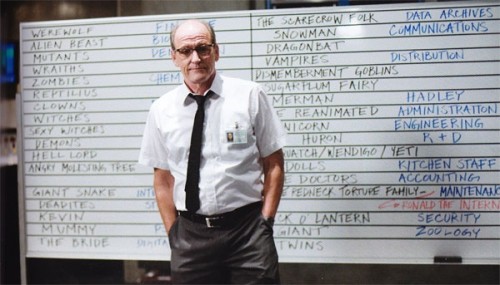
This spells disaster for the rest of the cast, not to mention the planet. Marty’s knowledge and insight disrupts the show and incurs catastrophe. And there’s something to that outside of the visceral pleasures the film indulges in. With the scope of Cabin in the Woods clear and visible, the film reveals itself to be a story about appeasement and the consequences of failing to mollify the expectations of the Ancient Ones; put that into perspective with the grim mien of Sitterson’s and Hadley’s work, and the pieces of Goddard’s puzzle box all begin to fall neatly into place.
In another film, Marty– a combination stoner/genius, two archetypes so integral to horror’s history– would clearly be the hero. He certainly plays the part for long enough in Cabin, coming to Dana’s rescue with his trusty telescoping bong. But his actions have calamitous consequences. That doesn’t make him the villain at all, but he’s screwing around with something that’s as old as time itself and integral to the continued existence of the entire planet. When Goddard brings Cabin in for its climactic landing, Marty makes a choice that ends the world and capstones the film’s commentary on the nature of horror cinema and fandom by tinkering with the basic expectations we bring to horror films in the first place.
Put succinctly, we’re the Ancient Ones. We’re the “customers” Sitterson and Hadley (and the Japanese, Spanish, Swedish, and other foreign equivalents) have been working so hard to satisfy; we’re the reason that Dana, Jules, Curt, Holden, and Marty are brought to the sacrificial altar, so to speak. They’re trying to entertain us and sate our appetite for bloodshed and carnage (and the occasional display of nudity). And at the end, they’ve failed, and more than that Marty and Dana both have bucked our expectations by not only surviving, but also by sending the entire facility into crimson-tinged, anarchic incongruity. Evil clowns and witches and zombies and werewolves all in the same film? Impossible!
Dissatisfied and defied by the very teens we wanted to see die (though I think we’d all be okay with Dana living; she just has so much heart), there’s only one thing left for us to do: act out and destroy. If we can’t have the murders we crave carried out in the exact fashion we demand, then we’ll take our outrageous compensation in return. And so the film ends: first the facility, then the cabin, and then the rest of the world. The message is simple– do not trifle with horror formulas, or risk incurring the wrath of your audience.
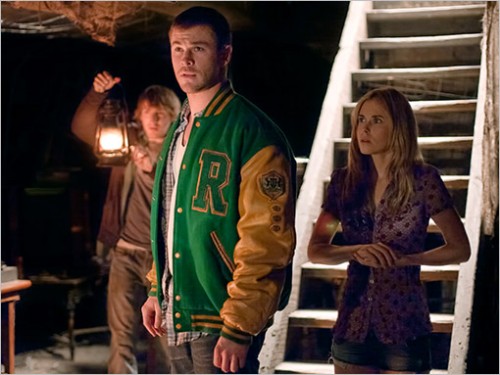
Made more robust, the film is a treatise on the necessity of these tropes, and that horror movies are ritualized to the point of mimicry because we require them to be. Cabin’s final shot, then, is less about displeasing a fickle audience than it is about the importance of genre regimentation. We watch horror films for very specific reasons; perhaps for the superficial thrill and titillation of their exploitative and graphic qualities, yes, but also because such cinema gives us the opportunity to confront our own fear of mortality. They let us face death. Going off of that basis Cabin in the Woods seems to be arguing that we need horror films, that they are necessary to deal with our own fear of death, and that to tinker with formula is to threaten the catharsis we get from watching horror films in the first place.
This is sort of a funny way for Cabin to end, because from start to finish the film goes entirely out of its way to usurp formula. Sure, the initial set-up is itself fairly standard, but that’s all very clearly undercut by the fact that we’re aware of the film’s “downstairs”– the facility, Sitterson, and Hadley– from the very beginning (which is to say nothing of the fact that as far as “cabin in the woods” horror goes, what Goddard does with the trope is actually pretty solid). If the Ancient Ones act as an audience stand-in in the horror cinema metaphor—or if we choose to interpret them as such– then Cabin ends up failing our expectations much, much sooner by playing with the curtain wide open from nearly the first frame.
Sometimes, though, we need to have our expectations supplanted. Sometimes, we need to see the formulas broken or rewritten or revised so that we can experience something new. Formulas keep us comfortable, but they also lead to stagnation, staleness, and repetition, which in turn lead us to revolt against formulas and demand newness. Cabin, according to Goddard and Whedon, represents exactly such a reaction, and therefore is an act of criticism itself:
On another level it’s a serious critique of what we love and what we don’t about horror movies. I love being scared. I love that mixture of thrill, of horror, that objectification/identification thing of wanting definitely for the people to be alright but at the same time hoping they’ll go somewhere dark and face something awful. The things that I don’t like are kids acting like idiots, the devolution of the horror movie into torture porn and into a long series of sadistic comeuppances. Drew and I both felt that the pendulum had swung a little too far in that direction.
(Source.)
Observed through that perspective Cabin in the Woods‘ ending symbolizes Goddard and Whedon’s joint assault on contemporary horror, tearing it all down so as to foster the birth of something fresh in the aftermath. Perhaps that volcanic mitt we see at the end is theirs, come to wipe away the tropes and cliches and usher in the next era of horror filmmaking. If we process the film through this lens, Cabin means to retire the stereotypes and give the genre’s adherents the chance to tell stories with new ideas and original conceits.
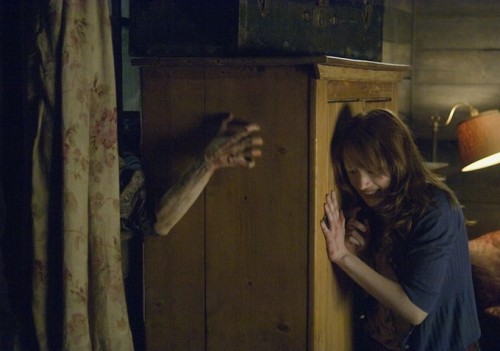
Certainly there’s validity to the idea that we need horror, and thus it’s perfectly acceptable to perceive Cabin in the Woods as a reminder of why we watch horror movies in the first place. But there’s a mountain of meta-textual evidence that points to the contrary idea, that Cabin is meant to deconstruct horror first and foremost** and act as a paean second. Through humor and character, in which Goddard and Whedon couch the bulk of their genre subversion, the film does much more to articulate the problems with those seemingly essential cliches than it does to reaffirm their necessity. In fact, the roots ofCabin’s meta-criticism are buried deepest in the mechanics of Sitterson and Hadley’s roles as technicians within the facility. If the Ancient Ones represent horror audiences, then Sitterson and Hadley are filmmaker surrogates who orchestrate the “picture”/sacrifice; they direct the entire show once the victims-to-be unwittingly choose, through temptation, which monster will serve as the agent of their demises, influencing events through liberal application of behavior-altering chemicals that lead logical, rational people to make foolhardy and reckless decisions.
In doing so, Sitterson and Hadley actually present a serious critique of horror by establishing its inherently inorganic qualities. Maybe part of horror’s appeal lies in watching characters make bad choices that we know will result in their grisly ends, but Cabin makes a strong point about such cliches being founded on fakery. As horror fans, we’re prepared to accept these fatally stupid choices because that’s part of the film-going ritual (and admittedly, grousing about teens wandering blithely through the dark, eerie woods on moonless nights is part of the fun of horror to some). Cabin puts this particular trope into a much more literal framework and as a result exposes just how artificial the majority of contemporary horror really can be thanks to dogged adherence to formula.
Of course, Hadley has hopes of playing with that formula to the limited extent that he can; he longs to see a merman in action, so much so that he puts his money on the fishy fiend in the facility’s annual betting pool. (Because when your job is to send innocent people to their dooms, what else are you going to do but try to profit off of it?) But his hopes are dashed when the Buckners rise from their graves and maintenance wins the pot. Sitterson can only console him by cracking wise: “If they were creative, they wouldn’t be in maintenance.” It’s a great one-liner, but there’s more to it than Whedon’s trademarked quippiness– it’s actually a sly jab at the cycles of self-cannibalization horror wrought by non-creative studio types. Instead of seeing his merman opus get made– something original in a flock of the ordinary– director Hadley has to make yet another redneck zombie movie (while in the background, his Japanese counterparts are enacting a similarly rote design with a spooky, pale child specter), something that will appeal to the masses instead of satisfy his artistic urges.
But next to Sitterson and Hadley’s sharp barbs and cutting parody, there’s also Marty, the man who refuses to indulge in their ritual of cliches. Once more, it makes sense to look at the climax first; faced with the terrible reality of the facility’s purpose, Marty declares that if humanity’s continued survival depends on this annual barbarism, then maybe the world needs to crumble so that “someone else” can have a chance at existence. In expressing his belief, he’s actually arguing against the very notion that Cabin is about celebrating the mores of horror and acknowledging their necessity: if we have to watch the same stories relentlessly retread to mine from horror those attributes and emotions we demand, then what’s the point? Shouldn’t those cliches be set aside to make room for the next generation of inspired, convention-defying genre cinema?
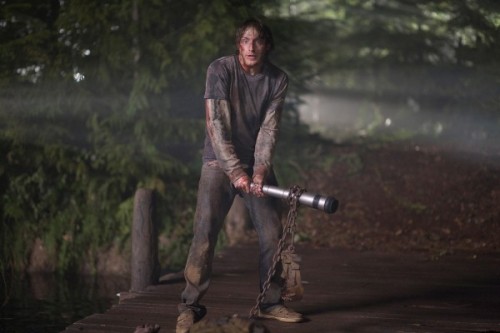
Cabin in the Woods itself serves as a loud proclamation in the affirmative to that query, and though the film admittedly is funnier than it is scary, there’s no doubt about its intentions or its place in horror canon. If the film outwardly had less serious goals and a more lighthearted bent, perhaps it would be nothing more than an amusing and bloody lark. That Goddard, along with Whedon, takes Cabin to its unexpected cataclysmic ending with so much unflinching verve indisputably grants the movie legitimacy within its cinematic hierarchy and strongly identifies it as an appraising comment more than a laudation. Leading up to that destination, the film digs at, assesses, and judges the archetypal characteristics of horror, sometimes reveling in them but more often revealing their failures and flaws before knocking down its own house of cards. When that fiery palm blacks out the camera as Cabin in the Woods meets its end, it’s signifying the end of horror as we know it and optimism for the future of the genre going forward.
*My partial list: torn apart by a werewolf, sliced and diced by a killer robot, chewed up by an angry tree, devoured by giant snakes, krakens, dragon bats, and zombies, tortured by a cenobite, burned alive by the Strangers, gutted by an evil clown, soul torn away by a witch, drowned in deadite vomit, ripped in half by dismemberment goblins, mauled by a merman, disemboweled by scarecrow folk, lethal operation by sadistic doctors, impaled by a unicorn, pounced upon by an alien creature (alternate: stalked by an alien creature), and smothered by a serial killer. What have you got?
**Though there’s definitely an argument to be made that the entire act of critiquing the genre could itself be seen as an act of love.

